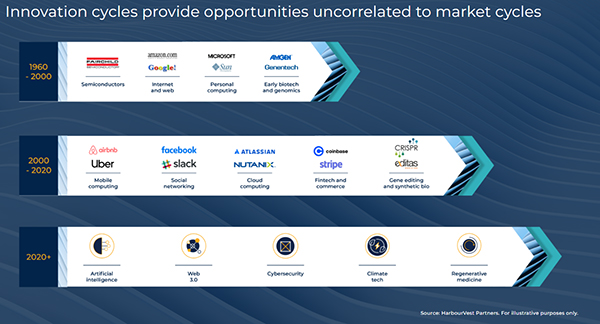Catch the next wave: Innovation cycles continue to create compelling opportunities in venture capital for family offices

Macroeconomic challenges impacting global financial markets have created an atmosphere of slower, more targeted private capital deployment. Yet, having experienced incredible returns over the last ten years [1], venture capital continues to offer family office investors opportunity for outperformance relative to both public market equivalents and other private markets sub-asset classes [2].
Four regional leaders from HarbourVest’s global Primary Investment team share their insights on the current state of venture capital, why investment in venture remains vibrant despite market volatility, and where opportunities in venture capital lie going forward.
What have you been seeing broadly in terms of venture valuations?
Scott Voss (US): Private markets typically mute and lag public markets, and when there is unusually high volatility with short term swings it is difficult to anchor on true fair market value. Many of the markdowns that we saw in 2022 were a result of public positions connected to recent IPO activity trading down significantly. On the private side, we saw managers proactively make valuation adjustments that were reflective of the public market correction. We think 2024 will be a big year for companies going back out to the market to raise their next round and this will test the legitimacy of current carrying values.
Amanda Outerbridge (US): With continued public market volatility, there is an uncertainty that hangs over valuations. Over the last few years, we have seen returns generated from hypergrowth companies where the path to profitability was far into the future. Today, there has been a shift away from “growth at all costs” and a heightened focus on viable, disciplined business models that can achieve profitability in the medium/near term. Late-stage venture capital and growth equity have been most impacted by public market comparables impact this end of the market more than early-stage and seed. We believe the early-stage valuations will continue to offer attractive entry points for investors where they can access the next generation of category leaders and gain high ownership to drive outsized returns.

Alex Wolf (Europe): The valuation environment in Europe is similar to that of the US. European venture managers are adapting their valuation methodology to today’s market and in many cases are taking discretionary mark-downs from the last round valuation to reflect company performance and reduced multiples for comparable businesses. Thus, in Europe we have seen very few down rounds to date.
Lydia Hao (Asia): Venture valuations in Asia took a similar path as their global counterparts. However, the magnitude of adjustments, both on the up and the down, have been lower. Compared to US and European venture markets, venture-backed companies in Asia saw more muted valuation uplifts during 2020-2021, resulting in less adjustment in 2022 and into 2023. Despite the pressure on valuations, many late-stage companies in Asia continue to deliver strong organic growth and improving operating metrics, demonstrating the resilience of founders and the attractive market fundamentals more broadly across Asia.
Why is now a good time to invest in venture?
Alex Wolf: Two words: innovation cycles. Innovation equals new company creation – the lifeblood of the venture industry. While macro headwinds do pose a challenge in the short term for the funding and financing of venture portfolio companies, the long-term outcome of truly great businesses is less impacted by these factors. Fundamentally, when companies are built to disrupt incumbents and incumbent business models with a focus on “better, faster, and cheaper,” they are less impacted by macroeconomic factors. We believe the current macro uncertainty creates a healthy consolidation across all stakeholders in the venture capital value chain – including entrepreneurs, portfolio companies, and managers – because it eliminates the “tourists.” Venture capital remains the most effective way to access future market leaders, and the current choppy market environment is setting up the next wave of venture disruption.
Lydia Hao: The previous innovation cycle in Asia gave rise to many highly recognizable venture-backed consumer internet platforms across markets. The existing infrastructure has matured, acting as a multiplier for next generation ideas. This is driving a new cycle of innovation which we believe will be broader across more country markets and a different set of sectors in Asia, such as software services, biotechnology, advanced manufacturing, and energy transition.

Where is venture headed in 2024 and beyond?
Amanda Outerbridge: Change creates the opportunity to reimagine, improve, and disrupt. There is significant excitement around artificial intelligence right now, and a question we often receive is whether there is real value. We view the recent technology breakthroughs within AI as creating fundamental, lasting value that provides an expansive and growing opportunity set. Two of the reasons we believe this are the dramatically reduced costs of modeling and the rapid adoption of AI products. Within AI, there are three broad categories where venture capitalists are investing, they are Core AI, Horizontal AI, and Vertical AI. Venture managers also continue to invest in cybersecurity, healthcare, biotech and fintech. Each moving forward with new methods to combat new vulnerabilities, reduce costs, improve the patient experience, revolutionize drug development, and reimagine the financial industry.
Lydia Hao: Asia is home to the second largest venture capital ecosystem globally after the US, with more than 400 unicorns spread across core markets of China, India, and Southeast Asia [3]. We are equally excited about the field of generative AI across Asia, which could have far-reaching impacts that intersect all of the sector themes discussed above. The long-term growth drivers for Asia’s venture opportunity set remain strong and we believe technology-driven solutions will continue to transform both consumer and enterprise-facing businesses uniquely tailored to Asian demands.
Alex Wolf: Europe continues to embed its position as a globally important center for innovation and entrepreneurship. We have now seen tech start-ups with assets greater than $1 billion founded in more than 50 cities across Europe [4]. These large, category-defining companies are producing a strong supply of repeat founders and ex-operators, which makes for a higher quality entrepreneurial base than we’ve ever had in Europe. Generative AI is clearly a key investment theme going forward in Europe, building on several years of investment into AI and machine learning. Europe also continues to lead the way in climate tech, sustainability, and purpose-driven investment themes such as: carbon capture, consumer durables and plant-based solutions.
Key Takeaways
1. New company creation remains active across the globe despite the overhang of economic and geopolitical uncertainty.
2. Venture capital, by investing in both intellectual property and business model innovation, can provide investors access to the future market leaders being created today.
3. Venture managers are being more disciplined around valuations, and continued valuation adjustments create more attractive entry points for the asset class.
The entrepreneurship and disruption that has fueled venture capital since it became an institutional asset class over 70 years ago persists today. As new innovation cycles emerge, upper quartile venture capital is poised to continue to lead the way in private market performance, presenting investors an opportunity to achieve very strong returns.
As always, skillful manager selection is critical to maximizing expected returns of a private market portfolio – and access to top managers is especially important for venture capital, which tends to have a wider return dispersion than other private market segments and public markets.
[1] Burgiss, data as of 12/31/2022.
[2] Burgiss, S&P 500, MSCI ACWI, data as of 12/31/2022.
[3] Source: HarbourVest, based on data from Crunchbase, International Monetary Fund, and World Economic Outlook Database, April 2023.
[4] Source: Accel, Europe and Israel’s startup founder factories and the founder journey, May 2023.
Disclosure
This material is solely for informational purposes and should not be viewed as a current or past recommendation or an offer to sell or the solicitation to buy securities or adopt any investment strategy. The opinions expressed herein represent the current, good faith views of the author(s) at the time of publication, are not definitive investment advice, and should not be relied upon as such. This material has been developed internally and/or obtained from sources believed to be reliable; however, HarbourVest does not guarantee the accuracy, adequacy or completeness of such information. There is no assurance that any events or projections will occur, and outcomes may be significantly different than the opinions shown here. This information, including any projections concerning financial market performance, is based on current market conditions, which will fluctuate and may be superseded by subsequent market events or for other reasons.






